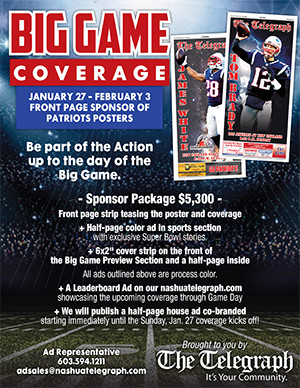Advertise team pride
You don’t have to live in a Super Bowl city to sell clients on a championship
When the New England Patriots went down 28-24 to the Kansas City Chiefs with 2:03 remaining in the NFC Championship Game, The Telegraph's Patriots Pride advertising promotion was looking uncertain. Last year's series of wrap sections and posters proved successful, but the Patriots hadn't been as strong this season and plans had been scaled back.
But when the team came back to win in overtime, the promotion was a go for the paper in Nashua, N.H., a Boston-area bedroom community that covers a strong part of New England's fan base.
So starting this past Sunday, The Telegraph is selling ads around posters of players inserted each day and posted on the website NashuaTelegraph.com for downloading as part of the paper's E-Edition. On Saturday before the big game, the paper will run a four-page wrap around the regular eight-page A section. Should the Patriots beat the Los Angeles Rams in Super Bowl LIII, readers may expect to see a commemorative special section as well.
Last year's series of wrappers and posters ran throughout the playoff series and generated $14,240 in revenue. Everything was full color.
"The Patriots are a way of life here," said Publisher Heather Henline. "We were surprised at how well the posters were received, not just by the advertisers but by our readers."
A newspaper company doesn't have to be located in or near a Super Bowl city to do a similar campaign, Henline said. "They can do this for any major team that they would have for professional sports, for football, baseball, hockey or basketball."
During her career with Ogden Newspapers Inc., Henline has done similar promotions with the West Virginia and Penn State university teams. This concept also translates to high school sports, depending on how popular prep sports teams are in a particular community, she explained. NASCAR events or local golf courses are other potential subjects, she said.
For The Telegraph wrappers, a strip sold on the front ran across the bottom of the page with the poster and ads were on the inside pages. Advertisers could choose a premium position, paying extra to select a particular player for their poster. For single-page poster days, the paper would sell the strip page and the back page to one advertiser.
In Nashua, people cut out the posters and put them up in homes and businesses to display their team pride. One man in a nursing home decorated his living space with every poster and wrapper. A woman put the poster series up in her high-end kitchen in her home, decorating the front of her cabinetry.
"She had all of the posters hanging in her designer gourmet kitchen and was so proud to have this newspaper page on the front of that expensive cabinetry. It really spoke to the value that our content brought," Henline said. "This was something that really resonated with readers and subscribers."
Types of advertisers included restaurants, bars, gambling establishments, and tire and automotive stores. Even a couple of funeral homes bought ads, said Autumn Williams, advertising and marketing manager for The Telegraph. Advertisers wanted to be seen supporting the Patriots and part of that winning tradition.
"It allows them to show the community that they're a part of the community, with different things the newspapers are able to put out," Williams said. "It's a huge community project."
Content was readily available through The Associated Press; photos of players from AP archives were turned into posters by the newsroom staff. Henline said merchandising and copyright issues with the team are avoided by making the posters part of the news product and publishing them only in the print and E-Editions, not selling them separately. The key is only using images available through a newspaper's paid AP service agreement.
AP is offering more services to its clients and has provided training on how to use what's available as part of its content packages to help drive revenue, Henline said.
"We're not licensing cups or T-shirts. There's nothing outside of our printed core product, and even what we do online is part of our E-Edition. We have the ability through our AP membership and through the photos that we utilize to take those photos and use them in our paper as part of the news project, even though it's utilized to drive revenue. It's because we're not selling anything but selling our paper."
Photos taken by staffers also can be made into posters, and publicity material such as schedules and rosters that are generally distributed to news outlets can also fill wrapper sections for colleges and high schools.
Henline suggests other papers investigate everything in the AP package they're paying for to see what's available that might match up with a potential promotion in their communities via sponsorships. Don't overlook potential advertisers, like the funeral homes, that seemingly might not be the type one would expect to be interested in a sports project.
"I get so frustrated as an industry that we focus on all of this negative, and we don't do a good job of telling our own story of the successes and things that we do well," Henline said. "Our newspapers and our content matter. They resonate with readers and advertisers, and they drive results."
"Is this one project going to solve everybody's revenue issues? No. But the concept of how you can fill a need in a community and figure out what your Patriots team is, or whatever you can highlight in your market, sometimes we're afraid to do that. Go for it."
For more information, contact Heather Henline at hhenline@nashuatelegraph.com or Autumn Williams at awilliams@nashuatelegraph.com.
 |
|
Jane Nicholes |
Jane Nicholes, a regular contributor to the Southern Newspaper Publishers Association's eBulletin, is a freelance writer and editor based in coastal Alabama. She is an award-winning veteran of more than 30 years in the newspaper business. Reach her at jbnicholes@att.net.






